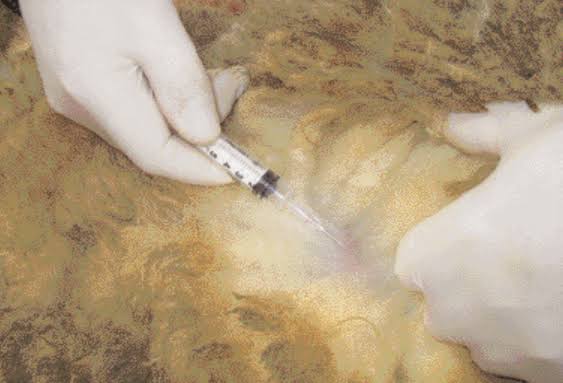

For sheep scab and wireworm, inject Ivomectin at least once a year, preferably at the beginning of winter. To treat heartwater, pneumonia, infected wounds or footrot, use intravenous or intramuscular injections. As most sheep vaccines are only 1ml, you can use a 2,5ml syringe with a short 20-gauge needle.
In the case of medicines, a 5ml syringe is big enough for most sheep and goat breeds, although you may need a 10ml syringe for a large ram.
For intravenous injections, you will probably need a 19-gauge needle. To prevent the transmission of diseases, it is essential to use a new needle for every animal. A crush pen is ideal for vaccinating sheep and goats, as you can catch the animals one at a time at the end of the crush.
Injecting sheep and small stock in a kraal
Many farmers simply catch the small stock and inject them in the kraal. If you do this, use a marker (a purple wound spray or a water-based paint are best) so that you don’t inject the same animal twice, or leave some out.
This method is better than putting the injected animals into another kraal, as the last few animals left in the first kraal tend to become panic-stricken.
A useful trick to working with sheep and goats is to move quietly and use herd behaviour. If three or four people walk slowly towards the flock in the kraal, the sheep or goats will huddle together with their heads turned into the corner.
Each ‘catcher’ should then slowly bend down and catch one sheep or goat by the hind leg and sit it on its haunches ready for the subcutaneous injection.
In sheep, this should be administered on the inside of a hind leg. In goats, the skin is very thin here and can become inflamed. Rather inject the skin behind the elbow.
Subcutaneous or intramuscular injections in the neck are not advised for goats, as their skin and underlying tissues are very sensitive and large swellings can develop, resulting in the goat suffocating.
Intramuscular injections in adult sheep and goats can be given in the rump, into the muscle that bulges between the hookbone and pinbone of the hip. In young animals, particularly goats, there may be very little muscle, so you may prefer to inject between a rib and the skin.
If you do so, be careful not to inject between the ribs, as you could accidentally introduce the medicine into the chest cavity and cause pneumonia or death.
Intravenous injections are given into the jugular vein, which is found in a groove from just under the throat to the edge of the shoulder. This is fairly easy to see in milk goats, as they have very thin skin and not much hair.
However, in Angora goats and Merino sheep, you will need to part the hair carefully in order to locate the vein. As with cattle, do not inject sheep or goats intravenously unless you have been trained by an expert.
 Contact Jaguza Support
Contact Jaguza Support